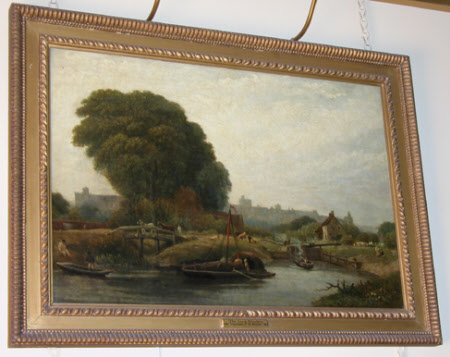The Old Lock, Windsor
Captain John Duncan King (1789 - 1863)
Category
Art / Oil paintings
Date
1852 - 1863
Materials
Oil on canvas
Measurements
451 x 673 mm (17 3/4 x 26 3/8 in)
Place of origin
Windsor
Order this imageCollection
Anglesey Abbey, Cambridgeshire
NT 515626
Summary
Oil painting on canvas, The Old Lock, Windsor by Captain John Duncan King (1789- Windsor Castle 1863), signed on reverse. The Old Lock in the right foreground, with barges waiting on the River Thames. Bridge in left foreground, over which two horses are passing. Windsor Castle with the Round Tower in distance, beyond trees. This is presumably one of the Thames scenes that Captain John Duncan King painted after 1852 when he was made a military knight of Windsor and resided at Windsor Castle. He had entered the army in 1806 and painted scenes in France, Spain, Switzerland and Germany, reminiscent of his early war-time experiences before moving to Windsor on his final promotion.
Provenance
Bequeathed to the National Trust by Huttleston Rogers Broughton, 1st Lord Fairhaven (1896-1966) with the house and the rest of the contents.
Credit line
Anglesey Abbey, The Fairhaven Collection (National Trust)
Marks and inscriptions
Signed on back of canvas: JDK (monogram) Gilt tablet affixed to bottom of frame, inscribed: : The Lock, Windsor, Capt J.D. King 1789-1863
Makers and roles
Captain John Duncan King (1789 - 1863), artist
References
Bunt 1949 Cyril G. E. Bunt, Windsor Castle through Three Centuries, 1949, Part I. OIL PAINTINGS 43. KING, CAPTAIN JOHN DUNCAN The Lock, Windsor Oil on canvas: 18 ½ x 27 ¼ The Old Lock in the right foreground, with barges waiting. Bridge to left over which horses are passing. The Castle and town beyond a mass of trees. [From the Collection of Colonel Grant. Illustrated in his book] [Captain King was Hon. Exhibitor at the R.A.]. Grant 1961 Colonel Maurice Harold Grant The Old English Landscape Painters, 1961, vol. 7, Pl. 319, illus. No. 643 and mentioned p.609. Anglesey Abbey, 1990-1992 [The National Trust; Robin Fedden] 1972, revised 1990, reprinted 1992., p.26: “The Upper Gallery Over half a lifetime Lord Fairhaven acquired a unique collection of views of Windsor. Comprising over 100 paintings, 150 watercolours and drawings and 500 prints, the collection faithfully charts the changes in the landscape and architecture of Windsor Castle over a period of three hundred and fifty years and must be one of the most complete topographical records of any site. Samuel Pepys called Windsor ‘the most romantique castle that is in the world’. It cast it spell on Lord Fairhaven at an early age, for his father owned Park Close, a house on the edge of Windsor Great Park, and later when he took up soldiering he was stationed at Windsor with his regiment, the 1st Life Guards. His first acquisitions were bought almost by chance for their historic and personal associations, but insensibly the ides of creating a complete topographical record from representative works of the artists of all periods caught his imagination. Windsor Castle and its surroundings are seen in every light and season, and from every quarter. Most painters have preferred to view the castle from the north where it rises nobly across the river, but others show what can be made of it less dramatic southern approaches. Yet other painters, such as W. Parrot with his record of the Montem celebrations in about 1848, introduce social and historical matter of a different but no less interesting sort. The earliest representations date from the reign of James I and it is understandable that the major seventeenth-century contributions when English topographical art was in its infancy, come from foreign artists. Clearly in a collection of this sort not every picture can pretend to be a work of art, but the level of executions remains surprisingly consistent. Among the eighteenth-century painters represented are Richard Wilson, Paul Sandby, and William Marlow; while distinguished painters of a later period include John Varley, David Cox, F.W.Watts, and Albert Goodwin.” Anglesey Abbey, 2006 [The National Trust] 2002, revised 2006, p.26: “Views of Windsor Lord Fairhaven had known Windsor since 1917, when his father bought Park Close, a house on the edge of Windsor Great Park. From 1916, when not at the front he was stationed at the Combermere barracks in Windsor with his regiment, the 1st Life Guards. He started collecting views of the castle as mementoes, but gradually became more systematic. By his death, he had assembled over 100 oil paintings, 150 watercolours and drawings and 500 prints, which together comprise the largest such survey outside the Royal Collection. They record the development over four centuries of the largest inhabited castle in the world, which has been a royal residence since the time of William the Conqueror. The 12th –century Round Tower dominates most of these views, the earliest of which dates from the beginning of the 17th century. Later artists represented include Paul Sandby, William Marlow and David Cox.”


